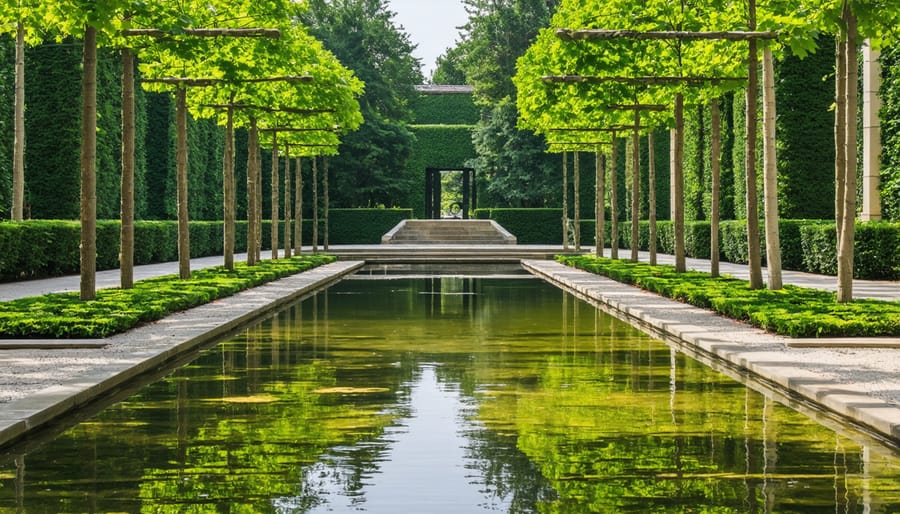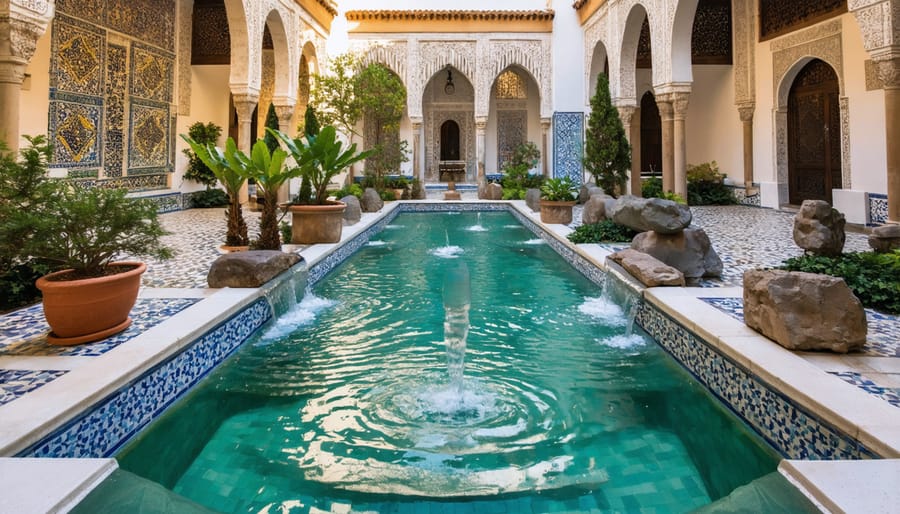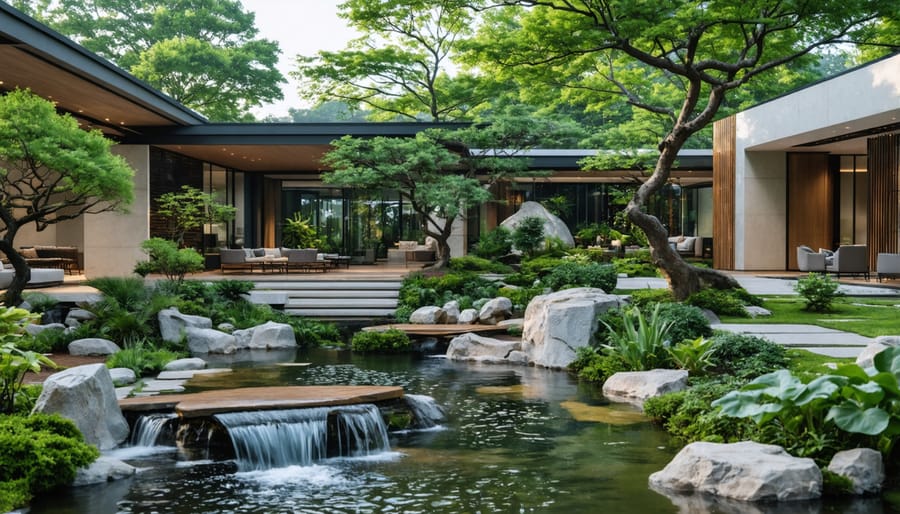
What Your Water Garden Says About Where You’re From
Water gardening traditions span continents and centuries, each culture bringing distinctive philosophies that transform simple ponds into meaningful spaces. Japanese gardens emphasize natural asymmetry and contemplative calm, using carefully placed rocks and minimal plantings to mirror mountain landscapes. Chinese water features celebrate abundance with colorful koi, lotus blooms, and symbolic elements representing prosperity. Persian gardens introduce geometric precision with cooling fountains and symmetrical channels that combat desert heat. Moorish courtyards showcase intricate tilework surrounding tranquil reflecting pools that create acoustic harmony through flowing water.
These aren’t just design choices—they’re practical solutions developed over generations to solve real challenges. Japanese gardeners perfected low-maintenance systems that work with nature rather than against it. Chinese innovators created biological balance through strategic fish and plant combinations. Persian engineers mastered water conservation in arid climates. Understanding these approaches gives you a toolkit of proven techniques, whether you’re working with a tiny balcony container or a sprawling backyard pond.
The beauty of exploring water cultures lies in mixing and matching. You might borrow the serene simplicity of a Japanese tsukubai basin for your entryway while incorporating the lush plantings of a Balinese water temple around your main pond. Perhaps you’ll combine Italian Renaissance fountain drama with English cottage garden informality. Your water feature becomes a personal expression that honors global wisdom while fitting your climate, space, and lifestyle perfectly.
Eastern Water Garden Traditions: Harmony and Symbolism
Japanese Water Gardens: The Art of Controlled Nature
There’s something almost magical about Japanese water gardens—they look effortlessly natural, yet every stone, every ripple, every plant is placed with incredible intention. If you’ve ever felt that peaceful pull when looking at photos of koi ponds or temple gardens, you’re experiencing what Japanese designers have perfected over centuries: the art of controlled nature.
Let’s start with koi ponds, which are probably the most recognized element. These aren’t just holes filled with water and fish. Traditional Japanese koi ponds follow principles of balance and asymmetry. The key? Nothing is perfectly centered. The pond shape flows organically, often with one side deeper than the other. When you’re planning your own version, think about creating visual interest through varied depths and irregular edges rather than a perfect circle or rectangle.
Then there’s the concept of wabi-sabi, which celebrates imperfection and impermanence. In water garden terms, this means embracing the weathered stone, the moss-covered basin, the asymmetrical rock arrangement. You don’t need brand-new, polished materials. In fact, that aged, slightly worn look is exactly what you’re after.
Tsukubai basins are another beautiful element you can absolutely recreate at home. These low water basins were originally used for ritual hand washing before tea ceremonies. They’re typically paired with a bamboo spout and surrounded by carefully chosen rocks. The gentle sound of water trickling into the basin creates instant tranquility. You can find basin kits online, or even repurpose a large stone bowl.
Rock placement deserves special attention. Japanese gardens often use rocks in odd-numbered groups—three or five stones arranged to look like they’ve always been there. Place the largest rock first as your anchor, then build around it. The goal is to suggest a natural landscape, like a miniature mountain scene.
Water flow in Japanese gardens is typically subtle. Think gentle streams rather than dramatic waterfalls. This creates that soothing, meditative quality that makes these spaces so restorative.

Chinese Water Culture: Feng Shui and Prosperity
In Chinese water culture, water represents prosperity, harmony, and the flow of positive energy throughout your life. I’ve always been fascinated by how intentionally Chinese gardens incorporate water—not just as decoration, but as a living element that brings balance to the entire space.
The lotus flower holds deep meaning in Chinese water gardens, symbolizing purity and spiritual enlightenment because it grows from muddy water to bloom beautifully above the surface. You’ll often see lotus ponds designed with these flowers as the centerpiece, and pairing them with complementary plant combinations creates stunning visual harmony that honors this symbolism without requiring you to follow every traditional rule.
Feng shui principles offer practical guidance for water placement in your garden. According to these teachings, water placed at the front of your home invites prosperity, while flowing water (like a fountain or stream) should move toward your house rather than away from it. Still water, like a pond, works best when positioned where it reflects natural light and creates a sense of calm. The key idea is that water should appear to embrace your space naturally.
Chinese gardens famously use water as a mirror, creating reflections that double the beauty of surrounding plants and structures. This technique makes even small spaces feel larger and more serene. You can achieve this effect by ensuring your pond has calm areas where the surface remains still enough to reflect the sky and nearby features.
When incorporating these elements into your own garden, focus on the underlying principles rather than copying specific designs. Consider positioning your water feature where it naturally catches light, ensure water flows gently rather than rushing, and choose plants that complement your climate. The goal isn’t to create an authentic Chinese garden but to learn from centuries of wisdom about how water creates harmony in outdoor spaces. This respectful approach lets you benefit from these time-tested principles while creating something uniquely yours.
Western Water Gardening: From Formal to Free-Flowing
European Formal Water Gardens: Symmetry and Control
When I first learned about European formal water gardens, I was intimidated by their sheer grandeur. Those Italian Renaissance fountains with multiple tiers and elaborate sculptures? The mirror-like reflecting pools at Versailles stretching seemingly forever? They felt impossibly out of reach for my modest backyard. But here’s what I discovered: the principles behind these stunning designs translate beautifully to smaller spaces.
European formal water gardens are all about symmetry and control. The Italians mastered the art of terraced fountains, using gravity to move water down hillsides in spectacular cascades. The French took a different approach, creating vast reflecting pools that turned the sky and surrounding architecture into living art. English estate ponds, meanwhile, balanced formality with natural curves, often featuring stone edging and classical statuary.
The secret to bringing these concepts home is understanding their core principle: water as architecture. You’re not trying to mimic nature here; you’re celebrating human creativity and order.
Start small with symmetry. A simple rectangular pond with matching planters on each side captures that formal essence. Even a tabletop fountain with a symmetrical design channels Italian grandeur. For a reflecting pool effect, keep your water surface clear and still. Skip the waterfall and avoid too many plants that break the surface. Position it where it can mirror something beautiful, like a favorite tree or your home’s facade.
The English approach works wonderfully for most yards. Create a kidney-shaped pond with formal stone edging, add a bench, and include one statement piece like a classical urn or small statue. You get that estate feel without needing actual acres.
Remember, European gardens celebrate intention and design. Every element serves a purpose in the overall composition. That mindfulness matters more than size.

American Naturalistic Movement: Wildlife Ponds and Native Plants
Here in North America, we’re witnessing an exciting shift in how we think about backyard ponds. Rather than focusing purely on ornamental displays, more water gardeners are embracing the naturalistic movement, creating ecosystem-focused water features that support local wildlife while requiring less maintenance. It’s a win-win approach that I’ve come to absolutely love!
The philosophy behind American naturalistic ponds is refreshingly simple: work with nature instead of against it. By incorporating native aquatic plants and designing wildlife habitats, you’re essentially letting your pond become part of the local ecosystem. The result? A thriving, self-sustaining water feature that attracts butterflies, dragonflies, birds, and beneficial insects.
Getting started is easier than you might think. Begin by researching plants native to your region. These species are already adapted to your climate, soil, and local wildlife, which means they’ll thrive with minimal intervention. Think cattails, rushes, pickerelweed, or water lilies specific to your area.
When designing your naturalistic pond, skip the rigid edges. Instead, create gentle slopes and varied depths to accommodate different plant types and provide access points for wildlife. Include shallow areas where birds can bathe and deeper zones for aquatic creatures to overwinter.
One tip from my own experience: resist the urge to keep everything tidy. Some algae and leaf debris actually benefit the ecosystem, providing food and shelter for pond inhabitants. I learned this after obsessively cleaning my first naturalistic pond, only to realize I was disrupting the very balance I wanted to create!
The beauty of this approach is that once established, these ponds largely care for themselves, giving you more time to simply enjoy watching nature unfold in your backyard.
Middle Eastern and Mediterranean Water Wisdom
Persian Paradise Gardens: Cooling Oases
Imagine stepping from the scorching Persian heat into a garden where the air suddenly cools by several degrees. That’s the genius of traditional Persian paradise gardens, and you can borrow their brilliant tricks for your own backyard!
These ancient gardens mastered the art of maximum cooling with minimal water through their famous quadripartite design. Picture dividing your garden into four sections with narrow water channels running between them, all meeting at a central fountain or pool. Why narrow channels? They reflect sunlight without wasting water through evaporation, unlike wide, shallow pools. The Persians knew that moving water in slim pathways stays cooler and creates a refreshing sound that psychologically enhances the cooling effect.
The real magic happens with strategic placement. By positioning these channels to catch prevailing breezes, the water naturally cools the air flowing over it before reaching your sitting areas. I tried this in my own garden by adding a simple channel just 15 centimeters wide alongside my patio, and the temperature difference was remarkable on summer evenings!
Persian fountains weren’t just decorative; they maximized surface area for evaporation exactly where you’d sit, creating a natural air conditioning effect. Modern water conservation techniques like recirculating pumps make this even more practical today. You don’t need acres to create this effect – even a small courtyard with one intersecting channel and modest fountain can transform your outdoor comfort while using surprisingly little water.
Moorish Courtyards: Small Space, Big Impact
I discovered Moorish courtyards during a cramped apartment balcony phase, and let me tell you – these designs were literally made for small spaces! Traditional Moorish gardens prove you don’t need acres to create something magical with water.
The genius lies in the central fountain principle. Even a simple bubbling bowl becomes hypnotic when surrounded by geometric tile patterns. I started with a 24-inch ceramic fountain on my tiny patio, and the sound alone transformed the space. The key is placing your water feature where it reflects light and can be heard from indoors – Moorish designers understood that water’s sensory impact matters more than its size.
Tile work is your secret weapon here. You don’t need authentic Moroccan zellige (though it’s gorgeous) – simple blue and white patterns around your fountain base create that instant Mediterranean vibe. I used standard mosaic tiles from the hardware store, arranged in a star pattern, and guests always ask where I found it.
For plant choices, think vertical and fragrant. Jasmine climbing a trellis, potted citrus trees, and herbs like mint and rosemary pack sensory punch without hogging space. Position them close to your water feature so their scent mingles with the cooling effect of moving water.
The magic happens at dusk. Add simple string lights or lanterns, and your compact courtyard becomes an evening retreat. It’s not about square footage – it’s about creating a complete sensory experience where every element works together.

Cross-Cultural Lessons for Your Own Water Garden
Matching Water Cultures to Your Climate
Your local climate is your best guide when choosing which water gardening tradition to embrace! If you live in a humid, temperate region with distinct seasons, Japanese-inspired designs will thrive naturally. These styles evolved in similar climates, so your koi pond or bamboo water feature will feel right at home with minimal fussing.
For those in hot, dry climates, Mediterranean and Middle Eastern approaches are your friends. Think Moorish courtyards with their efficient water use and cooling effects. These cultures mastered making every drop count while creating stunning oasis-like spaces. Consider incorporating raised pools, tiled fountains, and strategic shade plantings that don’t guzzle water.
In tropical or subtropical zones, you’ve hit the jackpot for lush Southeast Asian designs! Your climate supports exotic water lilies, papyrus, and dramatic foliage year-round. Embrace the abundance with layered plantings and naturalistic edges.
Living somewhere with harsh winters? Chinese garden principles work beautifully, as they’re designed to showcase seasonal changes. Your water feature becomes a dynamic element, beautiful even when partially frozen.
The secret is working with your climate, not against it. Choose a tradition that naturally suits your rainfall, temperature range, and seasonal patterns, and you’ll spend less time maintaining and more time enjoying your beautiful water garden!
Blending Traditions Without Creating a Mismatch
The key to successfully blending water traditions is restraint and intentionality. I learned this lesson the hard way when I first tried mixing Japanese and Mediterranean elements in my backyard pond. The result? A confusing jumble that honored neither tradition. Here’s what I’ve discovered works better.
Start with one dominant culture as your foundation, then carefully introduce accent pieces from another tradition. For example, if you’re building a Japanese-inspired pond, keep the naturalistic rocks and simple plantings as your base, but perhaps add a single Italian-style terracotta vessel as a water source. This creates conversation without chaos.
Pay attention to materials and their cultural context. Brightly glazed ceramic tiles from Morocco won’t feel comfortable next to weathered granite in a Japanese garden. Instead, look for shared elements between traditions. Natural stone, bamboo, and simple pottery appear across many water cultures and make excellent bridges.
Most importantly, research the symbolic meaning behind elements you’re borrowing. Avoid placing religious or deeply sacred items purely for decoration. When in doubt, stick with universal natural elements like plants, rocks, and flowing water that transcend specific traditions while still creating beauty.

Starting Your Cross-Cultural Water Garden Journey
Ready to dip your toes into cross-cultural water gardening? Start simple and let your curiosity guide you. Begin by choosing one cultural tradition that resonates with you. If you’re drawn to Japanese aesthetics, try placing a single stone in your existing pond with intention, considering how it creates balance with the water’s surface. Love the idea of English cottage charm? Add a cluster of water lilies or float some flowering plants in a decorative bowl on your patio as a mini water garden experiment.
Your local library or online resources offer wonderful books on international garden design that can spark ideas without overwhelming you. Visit botanical gardens in your area to see established water features from different traditions, taking photos and notes about what catches your eye.
For a beginner-friendly project, consider creating naturalistic ponds with a cultural twist. Maybe incorporate colorful Mexican Talavera tiles around the edge, or arrange river rocks in a pattern inspired by Asian rock gardens. Start small, enjoy the process, and remember that the best water gardens evolve over time, just like the cultures that inspired them.
When you step back and look at your water garden, you’re not just seeing koi swimming or lotus blooms opening. You’re participating in a beautiful tradition that stretches across continents and centuries. From ancient Chinese scholars finding peace beside their ponds to Japanese monks perfecting the art of simplicity, from English cottage gardeners celebrating abundance to contemporary designers blending it all together, water gardening connects us to something wonderfully human and universal.
Here’s the exciting part: there’s no single “right way” to create your water garden. The best approach is the one that resonates with you and works for your specific space, climate, and lifestyle. Maybe you’ll fall in love with the minimalist Japanese aesthetic but add some colorful English marginals because you can’t resist them. Perhaps you’ll create a Persian-inspired formal layout but stock it with native plants. That’s not just okay, it’s perfect.
I encourage you to experiment boldly. Try that Japanese bamboo fountain you’ve been eyeing. Plant those lotus you saw at the garden center. Add that piece of weathered driftwood. Mix traditions, bend rules, and create something uniquely yours. Your water garden is a living canvas where cultural traditions meet your personal vision.
Have you blended different cultural elements in your water garden? What combinations have surprised you? I’d love to hear about your cross-cultural water gardening adventures. Share your experiences, your successes, and even your happy accidents. After all, we’re all part of this global tradition together.
